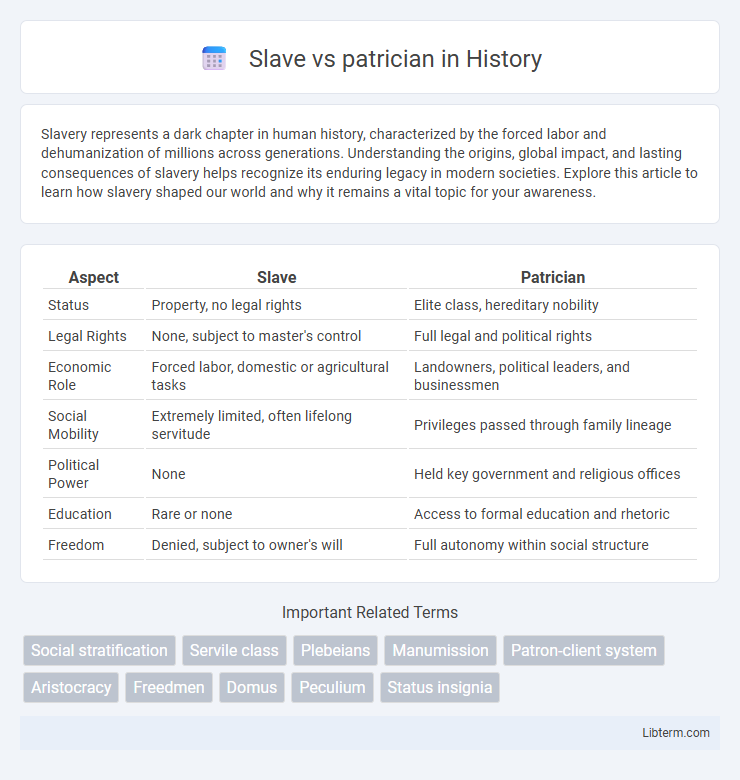Slavery represents a dark chapter in human history, characterized by the forced labor and dehumanization of millions across generations. Understanding the origins, global impact, and lasting consequences of slavery helps recognize its enduring legacy in modern societies. Explore this article to learn how slavery shaped our world and why it remains a vital topic for your awareness.
Table of Comparison
| Aspect | Slave | Patrician |
|---|---|---|
| Status | Property, no legal rights | Elite class, hereditary nobility |
| Legal Rights | None, subject to master's control | Full legal and political rights |
| Economic Role | Forced labor, domestic or agricultural tasks | Landowners, political leaders, and businessmen |
| Social Mobility | Extremely limited, often lifelong servitude | Privileges passed through family lineage |
| Political Power | None | Held key government and religious offices |
| Education | Rare or none | Access to formal education and rhetoric |
| Freedom | Denied, subject to owner's will | Full autonomy within social structure |
Historical Context: Origins of Slaves and Patricians
Slaves in ancient Rome primarily originated from conquered territories through wars, piracy, and debt bondage, their status deeply entrenched in the socio-economic fabric of the Republic. Patricians, the elite class of Roman society, traced their lineage to the founding families, holding exclusive rights to political and priestly offices during Rome's early monarchy and Republic. This stark division between slaves and patricians reflected broader structural inequalities rooted in birthright and conquest, shaping Roman legal and social hierarchies.
Social Hierarchy in Ancient Societies
In ancient societies, slaves occupied the lowest social tier, devoid of personal freedoms and subject to the authority of patricians, who were elite landowners and politicians with substantial power and privilege. Patricians controlled political institutions, held vast economic resources, and maintained social dominance, whereas slaves were primarily laborers or servants with no legal rights. This rigid social hierarchy reinforced systemic inequality and sustained the economic and political structures of classical civilizations.
Economic Roles and Contributions
Slaves in ancient Rome primarily performed manual labor and domestic tasks, providing essential workforce support in agriculture, construction, and household management, which significantly lowered labor costs and boosted overall productivity. Patricians controlled land ownership, political power, and major economic enterprises, driving economic growth through investment in large estates, trade, and financial activities. The economic roles of slaves and patricians were interdependent, with slaves enabling patricians to accumulate wealth and maintain social dominance.
Daily Life: Contrasts in Living Conditions
Slaves in ancient Rome endured cramped, dark quarters often located in the household's basement or external servant areas, lacking privacy and personal space. Patricians enjoyed spacious, well-decorated villas filled with natural light, elaborate frescoes, and comfortable furnishings that reflected their wealth and status. Daily routines for slaves involved rigorous labor and limited leisure, while patricians engaged in social activities, education, and leisurely banquets.
Rights, Privileges, and Legal Status
Slaves in ancient societies were considered property with no legal rights, subjected to the absolute authority of their owners and denied personal freedoms or political participation. Patricians, as members of the elite ruling class, enjoyed extensive rights and privileges, including property ownership, political influence, and legal protections under the law. The stark contrast in legal status between slaves and patricians underscored a rigid social hierarchy, where patricians held dominant roles in governance and society, while slaves remained marginalized and disenfranchised.
Education and Access to Knowledge
Patricians in ancient Rome had exclusive access to formal education, studying subjects like rhetoric, philosophy, and law under private tutors or in established schools, enabling them to pursue political and social leadership roles. Slaves, by contrast, were largely denied formal education, though some were trained by their owners in specialized skills or literacy to serve household or administrative functions. This stark disparity in education reinforced social hierarchies and limited slaves' opportunities for social mobility or intellectual development.
Power, Authority, and Influence
Patricians held concentrated power, authority, and influence through hereditary status and control over political institutions in ancient Rome, shaping laws and policies. Slaves possessed no formal authority or recognized influence, remaining subject to the absolute power of their owners without legal rights or social mobility. The stark disparity in power dynamics underscored a rigid hierarchy where patricians dominated governance while slaves functioned as subordinated labor with no decision-making capacity.
Marriage, Family, and Social Mobility
Slave marriages were informal and lacked legal recognition, whereas patrician marriages reinforced social status through formal, legally binding contracts. Family structures in patrician households emphasized lineage, inheritance, and political alliances, contrasting with slaves who had limited family autonomy and faced separation risks. Social mobility was nearly impossible for slaves, while patricians maintained and enhanced their elite status through strategic marriages and property consolidation.
Symbolism and Cultural Perceptions
The slave symbolizes subjugation and lack of autonomy, embodying themes of oppression and societal hierarchy in ancient cultures. Patricians represent elite status, power, and control, often depicted as the guardians of tradition and political authority in Roman society. Cultural perceptions framed slaves as laborers and moral inferiors, while patricians were idealized as noble leaders and patrons of civic virtue.
Lasting Legacy and Modern Perspectives
The contrasting roles of slaves and patricians in ancient societies have left a lasting legacy evident in contemporary discussions on social hierarchy and human rights. Patricians, as elite ruling classes, shaped legal systems and cultural norms that reinforced class distinctions, while the experiences of slaves highlight enduring struggles against oppression and inequality. Modern perspectives often reexamine these historical dynamics to promote social justice and challenge systemic discrimination rooted in class and power disparities.
Slave Infographic

 libterm.com
libterm.com